
Back
Carallia brachiata (Lour.) Merr.
| Family Name: | Rhizophoraceae |
| Synonyms: | Carallia scortechinii, Carallia integerrima, Carallia spinulosa, Carallia lucida, Bruguiera brachiata |
| Common Name: | Corkwood, Corky Bark, False Kelat, Maniawiga, Bongbong, Bongkok, Gandang, Ganding, Janggut Keli, Kesinga, Mesinga, Merpoi, Mersinga, Merpuing, Tengkawa, 竹节树 |
Carallia brachiata or Corkwood is a large tree growing as tall as 50 m but in Singapore, it usually grows to 20 m tall. The leaves are dark green coloured above, yellowish with brown spots below with toothed margins. They also bear small, white to pale greenish flowers and red round fruit. Corkwood is a suitable tree for large gardens, roadsides and parks.
Name
Classifications and Characteristics
| Plant Division | Angiosperms (Flowering Seed Plants) (Dicotyledon) |
|---|---|
| Plant Growth Form | Tree (Big (>30m)) |
| Plant Shape | Rounded, Oval |
| Maximum Height | 50 m |
Biogeography
| Native Distribution | From Madagascar to India, Sri Lanka, Myanmar, south China, Southeast Asia (including Singapore) to Australia, and Solomon Islands |
|---|---|
| Native Habitat | Terrestrial (Primary Rainforest, Mountain, Secondary Rainforest, Coastal Forest), Shoreline (Mangrove Forest, Sandy Beach) |
| Preferred Climate Zone | Tropical, Sub-Tropical / Monsoonal |
| Local Conservation Status | Native to Singapore (Vulnerable (VU)) |
Description and Ethnobotany
| Growth Form | It is usually a tree with a single trunk up to 50 m tall, but in Singapore, it is usually only about 20 m tall. |
|---|---|
| Trunk | Its bark is brown, and its twigs are conspicuously swollen at the nodes. |
| Foliage | Its opposite, stalked leaves have leathery leaf blades that are usually oval or drop-shaped, and 4–15 by 2–10 cm, with rather sharp tips. Its leaf blades are dark green above, and yellow-green with brown spots below. |
| Flowers | Its flowering shoots are divided into two equal, or three branches, and 1–6 cm long. Its flowers are stalkless, or shortly-stalked, white or pale-greenish, 3 mm long, and develop from the angles of leaves. |
| Fruit | Its fruits are round berries up to 7 mm wide, and ripen from pink to red. Their fleshy pulp contain many seeds. |
| Habitat | It grows in lowland and hill forests up to 1,800 m altitude. In Singapore, it grows in the landward edge of mangrove forest, and sandy beaches. |
| Similar | This species resembles the common kelat (Syzygium lineatum) owing to its oval or round crown. |
| Associated Fauna | It is the preferred local food plant for caterpillars of the teak defoliator moth (Hyblaea puera), the adult of which lays its eggs singly near the veins, and on the undersides of new leaf blade. Its flowers are insect-pollinated, and its red fruits are eaten by birds too. |
| Cultivation | It is propagated by seed or terminal branch cuttings. Seeds need to be germinated immediately as their viability decreases rapidly. In Tropical Asia, fresh seeds have a viability of 45% to almost 100% within 1–3.5 months. Seedlings should also be planted in the nursery for two years after which, they may be transplanted to semi-shaded sites as they are sensitive to drought, and shade-tolerant. It requires full sun, and is tolerant of damp ground. It is a tree suitable for large gardens, roadsides, and parks. |
| Etymology | Caralliam, translated from karalli, an Indian name; Latin brachiata, branched at right angles or arm-like, referring to the branching of the flowering shoot. |
| Ethnobotanical Uses | Edible Plant Parts : Edible Fruits Food (Fruit or Vegetable) Medicinal: The leaves and bark are used medicinally against itch and septic poisoning. Timber & Products: The wood is used for many construction purposes such as cabinet work, interior finish, railway carriages, pallets, and packing material. The wood is also a source of good-quality firewood and charcoal. |
Landscaping Features
| Landscaping | It is suitable for planting in parks, gardens and streetscape for its attractive form. |
|---|---|
| Desirable Plant Features | Ornamental Form |
| Landscape Uses | Coastal, Suitable for Roadsides, Parks & Gardens, Small Gardens, Beachfront / Shoreline |
Fauna, Pollination and Dispersal
| Fauna Pollination Dispersal Associated Fauna | Bird-Attracting, Caterpillar Moth Food Plant |
|---|---|
| Pollination Method(s) | Biotic (Fauna) |
| Seed or Spore Dispersal | Biotic (Fauna) |
Plant Care and Propagation
| Light Preference | Full Sun |
|---|---|
| Water Preference | Moderate Water |
| Plant Growth Rate | Moderate |
| Rootzone Tolerance | Moist Soils, Well-Drained Soils, Fertile Loamy Soils |
| Propagation Method | Seed, Stem Cutting (Tip) |
Foliar
| Foliage Retention | Evergreen |
|---|---|
| Mature Foliage Colour(s) | Green |
| Mature Foliage Texture(s) | Leathery |
| Foliar Type | Simple / Unifoliate |
| Foliar Arrangement Along Stem | Opposite |
| Foliar Attachment to Stem | Petiolate |
| Foliar Shape(s) | Non-Palm Foliage (Obovate, Oval) |
| Foliar Venation | Pinnate / Net |
| Foliar Margin | Dentate, Serrate / Toothed |
| Foliar Apex - Tip | Acuminate, Acute |
| Foliar Base | Cuneate |
| Leaf Area Index (LAI) for Green Plot Ratio | 4.0 (Tree - Dense Canopy) |
Non - Foliar and Storage
| Stem Type & Modification | Woody |
|---|---|
| Root Type | Underground (Tap Root) |
Floral (Angiosperm)
| Flower & Plant Sexuality | Bisexual Flowers , Bisexual Flowers |
| Flower Colour(s) | Green - Light Green, White |
|---|
| Flower Grouping | Cluster / Inflorescence |
| Flower Location | Axillary |
| Flower Symmetry | Radial |
| Individual Flower Shape | Stellate / Star-shaped |
| Flowering Habit | Polycarpic |
Fruit, Seed and Spore
| Mature Fruit Colour(s) | Red, Pink |
|---|---|
| Fruit Classification | Simple Fruit |
| Fruit Type | Fleshy Fruit , Non-Accessory Fruit |
References
| References | Hou, D. (1955). Rhizophoraceae. Flora Malesiana, ser. 1, Spermatophyta, vol. 5. Leiden: Naturalis Biodiversity Center. |
|---|
Image Repository
Others
| Master ID | 1488 |
|---|---|
| Species ID | 2781 |
| Flora Disclaimer | The information in this website has been compiled from reliable sources, such as reference works on medicinal plants. It is not a substitute for medical advice or treatment and NParks does not purport to provide any medical advice. Readers should always consult his/her physician before using or consuming a plant for medicinal purposes. |

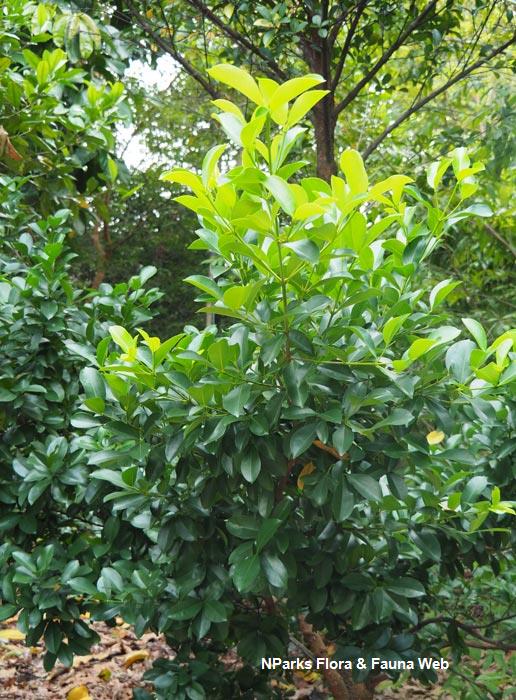

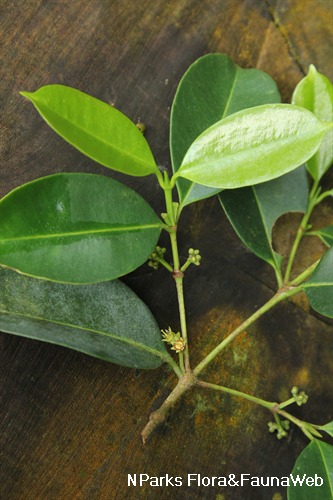

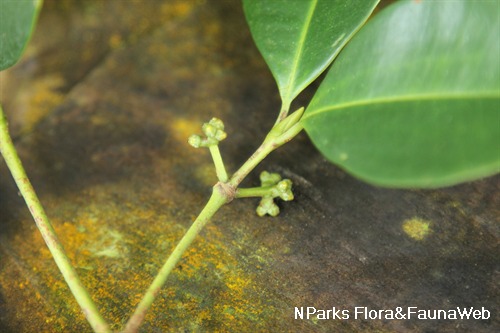
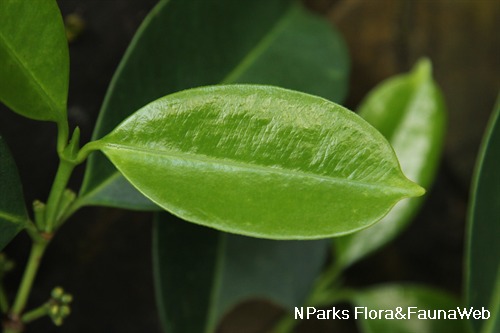

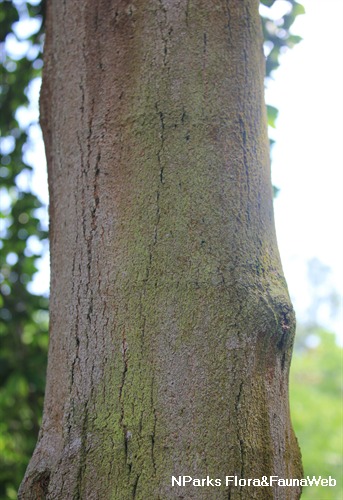
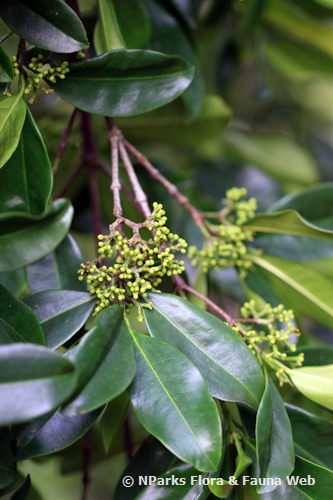
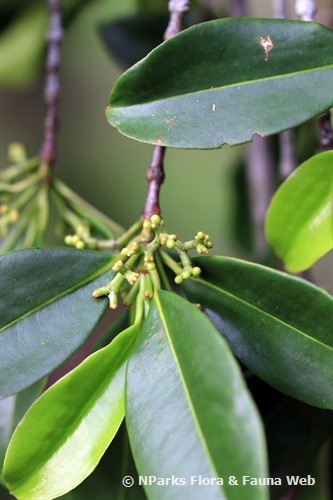
_lowres.jpg)
_lowres.jpg)